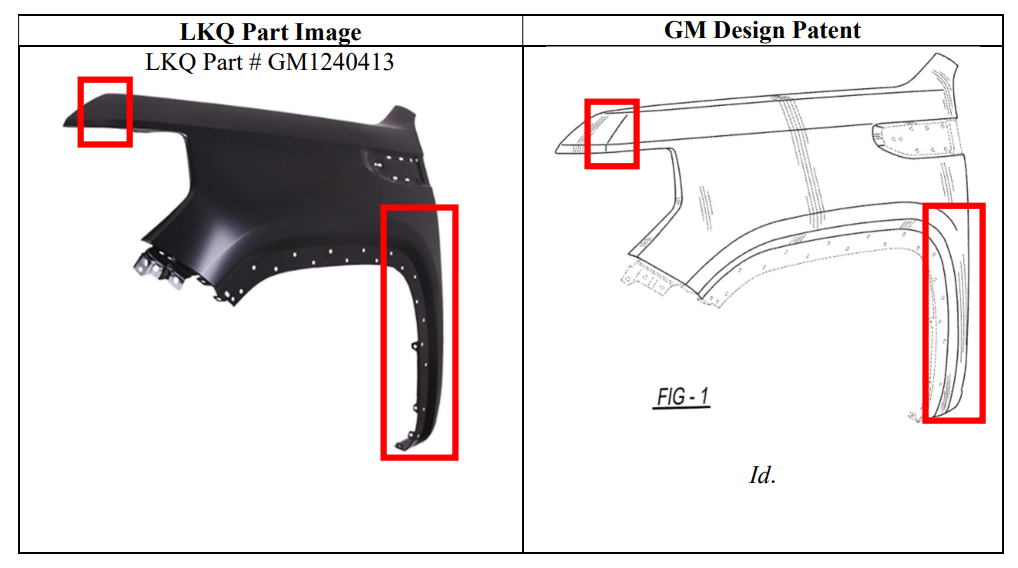
ACA backs LKQ & Keystone in alleged GM patent infringement case
By onLegal
The Auto Care Association has voiced its support of LKQ Corp. and its subsidiary Keystone Automotive Industries in their lawsuit appeal against General Motors over the automaker’s accusation that the companies have committed patent infringement.
LKQ and Keystone appealed the district court’s decision, which is where the case is now.
“The Auto Care Association’s filing supports the position that it is crucial that minimal design changes do not effectively grant Original Equipment Manufacturers (OEMs) a monopoly over individual replacement parts for the useful life of the vehicle and therefore that the Court should adopt the KSR test for design patent obviousness,” ACA said in a news release.
In its filing, ACA cites the National Highway Traffic Safety Administration (NHTSA)’s findings that in 2021, more than 6.1 million car crashes were reported to the police and were significant enough to require body work, and according to ACA’s estimates, cost consumers $44.3 billion in 2022. And 71% of that repair revenue was paid to the country’s more than 35,400 independent body shops, ACA wrote.
“Design patents for automobiles (including the fenders involved in this case) affect competition and consumer choice in the aftermarket for body work,” ACA wrote. “…Consumers prefer independent body shops because they offer quality repairs with lower costs of service and use less expensive non-OEM replacement parts.
“As the Federal Trade Commission recently observed in its Nixing the Fix report to Congress, ‘Where non-manufacturer parts are available, competition can rein in cost, as historically exemplified by the auto industry. For example, the [Auto Body Parts Association] stated in its empirical research submission that ‘[f]or more than 60 years, the alternative collision parts industry has been offering quality alternative parts to consumers, typically 15-50% less expensive than car company non-patented.”
It should be noted, however, that there are plenty of independent body shops that use OEM parts for repairs when required by OEMs in their repair procedures, when customers prefer them, and when state law or insurance requires them. Oftentimes, insurance carriers fight shops on following OEM repair procedures, especially those that require OEM parts, because not doing so and cutting corners is a cost-saving measure they prefer to take.
In the intellectual property suit, filed in November 2021 and amended in January 2022, LKQ and Keystone allege they didn’t infringe on two GM patents regarding vehicle fenders.
“[A]utomotive manufacturers began to zero in on design patents as an avenue not only for protecting their whole vehicle designs from competing automakers (a legitimate use of such intellectual property), but for monopolizing the replacement parts market for their vehicles by obtaining design patents for individual exterior parts,” the complaint states.
“…Specifically, as GM has done, OEMs began describing the venerable aftermarket replacement parts industry participants, which had for a century supported their customers and breathed value into their products, as ‘copycats’ and ‘pirates’ despite the inherent absurdity, in context, of such a characterization (a dissonance noted by the House Judiciary Committee at the time). In response to this OEM monopolistic effort, LKQ obtained license agreements from those OEMs seeking to enforce their patents.”
The patents in question are GM’s D818,406 and D828,256. Regarding the 406 patent, the plaintiffs argue that fender design by Mitsubishi on its 2016 Pajero Sport looks basically the same as GM’s patented fender design and that the 2015 Toyota Tundra looks similar to the Pajero Sport’s. A similar argument is made for the 256 patent — the patented fender design has the same overall visual appearance as the 2015 Chevrolet Colorado.
Their argument is that the patents aren’t infringed upon “because an ordinary observer would not be confused into thinking that the design of the LKQ parts and the design… are substantially similar.”
ACA wrote in support of the plaintiffs that the court should overrule the prior test used for design patent obviousness, vacate the decision of the Patent Trial and Appeal Board, and remand — with instructions — to reconsider.
“For example, unlike the Rosen/Durling analysis requiring that virtually all design elements be contained in a ‘primary reference,’ KSR states that ‘[o]ften, it will be necessary for a court to look to interrelated teachings of multiple patents; the effects of demands known to the design community or present in the marketplace; and the background knowledge possessed by a person having ordinary skill in the art, all in order to determine whether there was an apparent reason to combine the known elements in the fashion claimed by the patent at issue.'”
Images
Featured image credit: May Lim/iStock
Part images pulled from LKQ’s amended complaint


